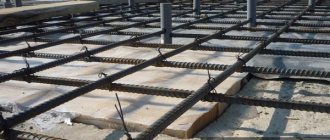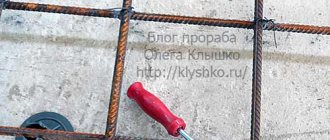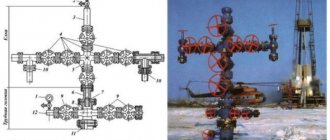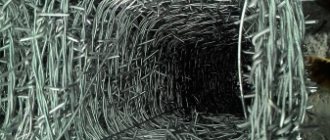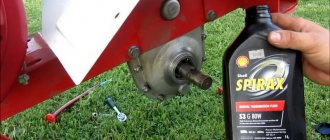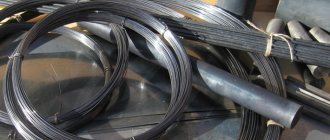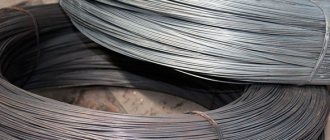How many meters of binding wire are needed is calculated in each individual case, since there are no consumption standards. The amount of reinforcement required depends on the diameter, pitch of the rods and dimensions of the frame. It is impossible to determine the exact consumption of binding wire per 1 cubic meter of concrete or ton of reinforcement, so make a rough calculation and take a reserve. It is recommended to buy 1.5 times more material than the amount that was calculated. The reason for this reserve is the high probability of the tying wire breaking when tying reinforcement units. With a diameter of 1.2 mm, the material reserve is even greater.
Two calculation methods are used:
- Tying one knot requires 10-50 cm of wire. The exact quantity depends on the diameter of the reinforcement and the equipment used for tying.
- For 1 ton the consumption is 10-20 kg.
Coils of knitting wire weighing 60-100 kg are on sale. When calculating, average data are used, but the error must be taken into account. When it is necessary to install a frame for pouring a floor screed, they resort to calculations based on the number of nodes per meter. If it is necessary to strengthen large areas with reinforcement (when arranging the foundation), they start from the consumption of 1 ton of concrete composition.
When calculating the required amount of material, the following parameters are taken into account:
- diameter of tied rods;
- diameter of tying wire;
- number of strapping knots.
If there is an intersection of two horizontal rods with vertical ones, the amount of wire used doubles. In the middle of the structure, you can make nodes in a checkerboard pattern, through the joint. At the same time, the binding at the edges should be complete.
Calculation by number of nodes
To more accurately determine the consumption, take into account how much wire is required to knit one knot. The thinner the wire, the greater the consumption, since several turns are made around the rods. To connect two rods with a cross-section of 10 mm, you need a wire 25 cm long; if three rods are connected, 50 cm. Having determined how much is needed per knot, multiply this amount by the number of knots. When purchasing, you need to know the weight in kg of 1 meter of knitting wire in order to calculate the load.
Calculation for 1 ton of concrete mixture
To calculate the consumption per 1 ton of concrete mixture, you should focus on the reinforcement diagram, and also count the number of joints between the rods. The accuracy of the calculation is complicated by the presence of cells of different sizes, so the step is not constant and the number of nodes in the area varies. The presence of a reserve of 30-40% allows for full reinforcement.
Types of wire
According to GOST 3282-7, various types of general purpose wire are produced, however, only heat-treated wire is suitable for tying reinforcement. It is marked with the letter O. Annealing is used to return the product to its original ductility, which is lost during drawing.
The production process begins with broaching. At this stage, the product receives its geometric size. Next, it is sent to bell furnaces for firing in a nitrogen environment. Since the wire does not have contact with oxygen during annealing, its surface remains light and is not covered with scale. By this feature, you can distinguish rolled products made in accordance with GOST from lower-quality analogues. If the product was fired in oxygen, it will have a black coating that leaves marks on the hands. In this case, knitting of reinforcement with knitting wire is done while wearing gloves.
There is also galvanized binding wire. It is marked with the letter C. However, its use in monolithic works is not advisable, since the concrete solution reliably protects the connecting nodes from exposure to oxygen. It is more suitable for the construction of fences, the manufacture of gabions and other products that will be used in the air.
Which binding wire for reinforcement is better? There is no clear answer. The products are identical in their physical and mechanical properties. The question comes down to price, scope of use, convenience and speed of operation.
.. | Knitting wire GOST 3282 74. How much wire is needed to tie the reinforcement.
Knitting wire GOST 3282 74 . How much wire is needed to tie the reinforcement.
In the production of general-purpose low-carbon steel wire in accordance with GOST 3282, after heating and then cooling, a wire with scale is obtained - dark wire, and without scale - annealed, light wire. Our company sells annealed wire - heat-treated, hardened, it is also called knitting wire. It is more flexible and durable, and breaks less often when bent than untreated. An annealed wire knot tightly fixes the reinforcement in specified positions.
Steel knitting is used not only for tying reinforcement, but also in the production of mesh, nails, for decorative purposes, for braiding cables, and for holding structural elements during welding work.
Compared to reinforcement cages connected by welding, foundations connected with binding wire are the most durable. The reinforcing metal frame connected by knitting wire is flexible and elastic, and in the event of soil swelling or soil freezing, deformation of the foundation does not occur.
Galvanized binding wire prevents corrosion of the foundation metal; such a foundation is more durable.
Consumption of tying wire for reinforcement , weight of one meter
GOST 3282 wire is produced in coils, usually up to 100 kg. To determine how many meters of wire are in a coil, you must first calculate the specific gravity (the mass of one meter of wire), or use tabular data on the theoretical weight according to GOST (you will find it on our website). To calculate the weight of 1 meter yourself, you need to weigh a small piece of wire and divide it by the length of this piece in meters.
How to determine the consumption rate of binding wire?
The amount of binding wire required to perform a specific amount of work is determined depending on the diameter of the reinforcement and the number of nodes. When tying two reinforcing bars, a wire piece approximately 25 cm long is required, three – 50 cm.
A simplified version of the calculation is to multiply the number of connecting nodes by 0.5 m. The exact material consumption per node is determined experimentally. After calculating the footage, it is recommended to increase the result obtained by 1.5-2 times. The reserve is necessary in case of breaks and loss of wire sections.
It is impossible to determine the consumption of tying wire for 1 m2 of reinforcing mesh or 1 m3 without a specific reinforcement scheme. The consumption of wire hardware per 1 ton of reinforcing bars is 10-20 kg.
Concrete consumption in the manufacture of various structures: calculations and standards
As a rule, calculations of concrete solution costs are contained in the design documentation. However, if you are building your house, outbuilding and other buildings yourself, then you will have to carry out the calculations yourself. The cost of concrete work depends on their correctness.
Concrete costs depend on the type of structure being made.
How to make calculations for the foundation of a house
The amount of concrete costs depends on the type of foundation chosen.
Slab base
Such a foundation is a monolithic slab, poured under the entire house.
In this case, you need to know the area of the building and the thickness of the base.
- Let's give an example. It is necessary to pour a slab foundation, 10 cm (0.1 m) thick, under the house, measuring 9 × 9 m.
- The area of the slab is: 9∙9=81 m2.
- We calculate the filling volume: 81∙1=8.1 m3. Calculations for concrete screed are carried out in the same way.
This instruction did not take into account the stiffening ribs at the bottom of the foundation, which ensure its stability and rigidity.
They intersect and break the base into squares.
- For a 9x9 m foundation, ribs must be laid every 3 m.
- Their thickness is equal to the thickness of the slab itself, in our case it is 10 cm.
- The total number of ribs is 6 (3 across and 3 along), the length of each of them is 9 m.
- Consequently, their total length is 54 m. With a width and height of the ribs of 0.1 m, their volume is: 54∙1∙0.1=0.54 m3.
We add both numbers and get the result - 8.64 m3 of solution.
Tape base
Tape base.
The rate of concrete consumption per 1 m3 of such a foundation is also calculated simply.
For this purpose, you need to know the width, length, depth and height of the ground part of the base.
- Our example will be the same building with sides measuring 9 × 9 m. Its perimeter is 9 ∙ 4 = 36 m. Let the width of the base be 40 cm (0.4 m), the depth of 1 m, and the ground part 50 cm (0.5 m).
- In other words, the total height of the base is 1+0.5=1.5 m.
- We calculate the volume of the foundation: 36∙4∙1.5=21.6 m3.
Note! This calculation does not take into account partitions.
If they are in the project, you should sum up the volume of tapes for them and the volume of the main foundation.
Columnar foundation
Parameters taken into account during calculations.
To determine the cost of concrete for arranging such a foundation, you need to know the number, height and cross-section of the supports.
First, the mixture consumption per column is calculated, then the figure is multiplied by their number.
- When calculating the area of a support with a circular cross-section, the formula S=3.14∙R∙ is used. The letters mean: S is the required area, and R is the radius of the section.
- If the pillars are rectangular in shape, the area is calculated by multiplying their two adjacent sides.
- When the area of the support is found, it should be multiplied by the height of the supports and their number. This way you will find the volume of concrete you need.
Reinforcement consumption
The reinforcement is counted by determining its total length.
When pouring a structure with a reinforced frame, you should also calculate the cost of materials for it.
Twig frame
To calculate the frame, you just need to measure the entire length of the reinforcement.
The consumption of binding wire per 1 m3 of concrete is determined as follows.
- First, the connection method is determined. It can be like this: the transverse and longitudinal rods of the lower belt are fixed, then vertical rods are screwed to them. And the transverse and longitudinal reinforcement of the upper chord is already fixed to them.
- This means that at the intersection points of two horizontal and one vertical rods there will be 2 wire connections.
- To tie one intersection point of the reinforcement, 15 cm of tying wire is required. At the same time, it folds in half, therefore, it needs 30 cm for one connection.
Volumetric reinforcement
Volumetric reinforcement using fiber fibers is being used more and more widely. Unlike metal analogues, they are distributed evenly throughout the solution, increasing its astringent qualities and resistance to delamination.
Fiber consumption per 1m3 of concrete is given in the table.
| Area of use | Desired fiber size, in mm | Material consumption |
| Industrial types of floors | 12 and 20 | 0.6 kg/1 m3 - to avoid the formation of cracks during shrinkage. 0.9 kg/1 m3 - to increase the strength of concrete. |
| Concrete and reinforced concrete structures | 12 and 20 | 0.6 kg/1 m3 - to prevent cracking during hardening. 0.9 kg/1 m3 - to increase the strength of structures and avoid cracks. |
| Cellular types of concrete (foam concrete and non-autoclaved aerated concrete) | 12, as well as 20 and 40 | from 0.6 kg/1 m3, based on the required strength of the product. |
Waterproofing
Deep penetration waterproofing compounds are often used for concrete structures.
Note! For example, the consumption of Penetron per 1 m3 of concrete is not so great, but it prevents the penetration of moisture through the base.
In addition, the composition increases the strength and frost resistance of concrete.
This waterproofing is available in dry form. It consists of special cement, finely ground quartz sand and active chemical additives.
Penetron consumption per 1 m2 of concrete varies from 0.8 to 1.2 kg, which depends on the degree of roughness of the base.
Standards applied in production
The photo shows the consumption of materials for different factory-made concretes.
Concrete consumption rates in production are applied in accordance with the requirements of State Standard No. 14.322/83.
They reflect the maximum volume of solution that can be used to produce units of products or work. When drawing up standards, technologists take into account the useful consumption of material, its losses and waste. Based on them, the price of the products is determined.
In factories, the required volume of mixture for the production of a certain product is found by calculation or graphic-analytical method.
- The calculation method uses drawings and technical documentation. The consumption coefficient of concrete during its compaction is also taken into account.
- With the graphic-analytical method, real material costs are compared with protocol figures. Next, graphs are made and analyzed by computer programs.
Conclusion
It is extremely important to know the exact cost of the solution when carrying out work, be it the consumption of aerated concrete blocks per 1 m2 or mixtures for monolithic structures. This determines how you organize the construction process.
The video in this article will give you more food for thought.
Page 2
The drying time of concrete (or, to be precise, the time it takes to gain strength) is precisely the factor that significantly slows down any construction. And the main difficulty in this case is the fact that reducing this time can only be achieved by carrying out rather complex and costly activities.
Below we will describe what happens to the solution when it dries, and also provide a number of recommendations for optimizing this process.
Adjusting the moisture content of the material is an important factor in ensuring its performance
Drying concrete correctly
Main stages
Until the solution has set, it can be leveled
To understand how to dry concrete as quickly as possible and without loss of quality, you need to understand what happens inside the solution itself after pouring. If you do not take into account the chemical component (it is of interest only to professionals), then several stages can be roughly distinguished. For ease of analysis, we have compiled them into a single table:
| Stage | What's happening? |
| Grasping | As soon as we poured the solution into the formwork or mold (if we were not quick enough, then in the trough or container of the concrete mixer), the cement begins to react with water. In this case, primary hydration of the most active components occurs, and polymerization of part of the material occurs. As a rule, this process takes from 30 minutes to several hours. During this time, concrete remains fluid and can be processed quite simply. |
| Strengthening to design value | After primary hardening, the rate of cement hydration decreases markedly, but still remains at an acceptable level. During this time, the poured concrete hardens, gradually “assimilating” the liquid inside it. Under optimal conditions (humidity about 90%, temperature +15-20 0C) the process takes 28 days. During this period, the material should gain from 60 to 70% of the strength of its potential value. |
| Ripening | This stage is typical only for piece materials that are used in the production of prefabricated structures. The instructions recommend that after completing the technological cycle, keep the products in storage for some time, and only then put them into operation. This is a period of rest, during which a smooth completion of all internal processes occurs, and is called ripening. |
| Changes during operation | It should be noted that even after starting to use a completely dried structure, the process of cement hydration does not stop completely. If the material receives a sufficient amount of natural moisture from the air, then it gradually becomes more and more durable. However, this is typical only for those structures that are not exposed to the destructive influences of the external environment. |
Note! It is not worth artificially accelerating the course of these stages: if the solution loses moisture before the cement reacts with it, then part of the material will remain without hydration.
As a result, areas of uneven structure are formed within the thickness of the monolith, seriously reducing the strength of the concrete structure.
Dependence of strength on time and temperature
Factors influencing the process
So, we have characterized the main stages of the process. However, as we know from practice, the time required to dry the solution may vary.
What does it depend on?
- The first parameter that needs to be taken into account is the composition of the material. If necessary, various agents are added to the solution that can speed up hardening without compromising quality. Naturally, the price of the structure in this case increases significantly, which is why hardeners are not used en masse.
Note! The additive can work both in natural conditions and when heated.
In the second case, the most economical would be to use finely ground slag (approximately 25% of the total mass of Portland cement).
- The next factor is the humidity of the surrounding air. Of course, in a dry climate, dehydration of the solution will occur more quickly, but as we know, this will lead to the removal of water, which is necessary for hydration of the cement. Consequently, accelerating the process can lead to deterioration in the quality of the product or structure.
Dusting and cracking of the surface when drying out in the sun
- Finally, temperature is also important. With additional heating, the rate of polymerization increases due to the fact that the activity of the reaction between cement and water increases. Due to this, it is possible to either speed up construction or compensate for the decrease in temperature during the cold season.
In the cold, the material practically does not dry: additional heating is needed
- When talking about temperature conditions, we must not forget about frost. When the liquid freezes, the drying process of concrete practically stops. Moreover, the resulting internal ice, due to an increase in volume, expands the pores in the material, which leads to its premature destruction.
Recommendations for speeding up drying of concrete
When constructing a building with our own hands, we are often limited in time, but we do not want to sacrifice quality. That is why the question of how to quickly dry concrete without losing strength is of interest to many.
Here are some recommendations you can give:
- The less moisture there was initially, the faster it will leave the solution. It is for this reason that for non-responsible concreting (leveling the base under the foundation, pouring unloaded screeds, garden paths, etc.) a very thick solution is used.
- The reaction rate directly depends on the particle size: the smaller they are, the larger the contact area with water. Thus, by using finely dispersed binders and fillers, we can reduce the time required for concreting.
High-curing composition
Note! Finely ground cement is slightly more expensive than standard cement, and it is more difficult to find.
- If we are ready for financial investments, then we can modify the material at the stage of preparing the solution. To do this, we either prepare it based on quick-hardening cement, or add chemical modifiers (soda, potash, potassium chloride, sodium nitrite, etc.).
A separate group consists of thermal methods:
- Firstly, to prepare the solution, you can use water preheated to +60–800C. This will promote rapid setting and reduce the period of initial strength gain.
- Secondly, concrete formworks with high thermal insulation properties should be used. This way, the heat accumulated in the concrete will last much longer.
Steaming in autoclaves (in the photo - serial production of aerated concrete)
- Finally, in the industrial production of building concrete blocks, heat and moisture treatment is used. 8-12 hours in an autoclave with hot steam can effectively replace several weeks of drying in the open air.
Conclusion
Speeding up the drying of concrete to reduce construction time is only necessary if you know how to compensate for the loss of strength of the material. You should be very careful here, since a lack of water in cement can have a very negative impact on the reliability of the structure and its service life. This problem is covered in more detail in the video in this article.
masterabetona.ru
Calculator for the amount of wire for reinforcing a strip foundation
The construction of a strip foundation necessarily involves the installation of a reinforcing frame structure. The use of welding is not encouraged, and assembly is usually carried out using the technology of linking parts using steel wire.
Calculator for calculating the amount of binding wire for reinforcing a strip foundation
When planning such work, many calculations are made, including the amount of material required. This may seem like a trifle, but it still makes sense to get an idea of the number of knots to be tied and, therefore, the amount of wire required for this. A calculator for calculating the amount of binding wire for reinforcing a strip foundation will help with this.
The calculation is simple and understandable, but still requires some explanation. They will be given below.
Calculator for calculating the amount of binding wire for reinforcing a strip foundation
A few explanations on the calculation
As is known, the reinforcing frame of a strip foundation consists of the required calculated number of longitudinal rods, which are assembled into a volumetric structure using vertical and horizontal jumpers. For these jumpers, it is more convenient to use ready-made rectangular clamps rather than individual pieces of reinforcement. However, this does not affect the number of anchor points.
This means that it is necessary to count the number of intersection points of the reinforcement bars - it is in these places that the wire binding is carried out. And to calculate you need to know:
- The number of rods of longitudinal reinforcement of the tape.
- The total length of the strip foundation, taking into account both the external sides and, if available, internal jumpers for capital partitions.
- The installation step of the clamps (it can be arbitrary, but not more than 0.75 of the total height of the tape).
- In addition, you can take into account that in the area of corners or junctions of the tape, reinforcement is performed - the installation step of the clamps is doubled. This is also taken into account by the calculation program.
The calculator will first calculate the approximate number of points to be connected with twisted wire. This, by the way, can also be useful in the case when ready-made wire loops packaged in reels or plastic tightening clamps are purchased to tie the frame together.
Based on the approximate length of a piece of wire per knot of 300 mm, a recalculation is carried out, which will give the minimum length of wire for tying the frame. And since it is often sold by weight, at the same time the result will be obtained in weight equivalent, and for different types of BP grade wire, with a diameter of 1.0 to 2.0 mm.
Wire prices
If tying knots requires longer segments, then it is easy to increase the result proportionally - there will be no mistakes.
Let us emphasize one more point - this is a minimal amount of material obtained. Taking into account the fact that some nodes may break if tightened too tightly, and they will have to be redone, and the pieces of wire themselves can easily be dropped and lost in the turmoil of a construction site, it is advisable to also lay in a reserve, increasing the estimated amount by one and a half or even two times. Knitting wire is not an expensive material, and the remaining surplus can always be used during further construction.
How is the reinforcement of a strip foundation calculated?
the reinforcement of strip foundations , will help you correctly calculate the frame structure, with all the elements of its reinforcement . And another publication will take a closer look at the technology of knitting a reinforcing frame .
Pros and cons of joining using the knitting method
- The knitting process is less expensive than welding reinforcement.
- It does not require a qualified welder, equipment, or significant energy consumption, especially when it is not yet available on site.
- It only takes one day to train an experienced rebar knitter.
- The knitting technology leaves the frame some freedom of movement when pouring concrete and processing it with vibrators. In this case, the reinforcing bars occupy positions in which there are no significant mechanical stresses that threaten to break.
- Poor-quality strapping, the implementation of which was not monitored by the technical supervisor of the work, can give too much freedom to the rods. In this case, the geometric parameters of the frame may be distorted during pouring until the reinforcement reaches the surface, which is unacceptable.
There are 2 calculators on the page - one is less accurate, but you can easily and quickly get the result, the other (below) is more accurate, but additional information is required for the calculation.
Use these tying wire calculators to roughly calculate the amount of wire required, depending on the amount of reinforcement being tied.
When building foundations, walls, floors and other concrete works today, reinforcement is used, and to connect reinforcing bars at their intersections, fixation is required; the most commonly used method of connecting reinforcement is tying the reinforcement with tying wire.
The weight of the wire depends on its thickness. For tying reinforcement in private housing construction, 1.2-2mm wire is used; it rarely makes sense to use thicker ones, because It holds the knot well, but thicker ones cost more and are much more difficult to twist.
This calculator allows you to quickly estimate approximately how much wire you need to buy in kilograms, because it is in kg. The wire is indicated by the sellers and most likely no one will measure it in meters. The calculation is made based on the consumption rate as a percentage of the consumption of wire reinforcement with a diameter of 1.2 mm as the most commonly used.
To calculate how much binding wire is needed more accurately, you need to take into account all the intersections of the rods; this is not too difficult, especially if the structure is reinforced with meshes with a certain cell. At each point where two horizontal rods and one vertical one intersect, there are two tying wire connections in each row, i.e. do not forget to multiply intersections in one row by 2. Knitting the mesh is allowed in a checkerboard pattern, i.e. through one joint, but the two outer rows of each side must be knitted each intersection.
By counting and indicating the number of intersections in the calculator window below, you will get the approximate amount of wire in kg required to perform the reinforcement. The calculation is made taking into account the thickness of the binding wire, which must be selected from the list. The more accurately you count the number of intersections, be careful.
Calculations for the foundation
To reinforce a columnar foundation, ribbed reinforcement with a diameter of 10 mm is installed at the corners of the column. If the foundation cross-section is large, it may be necessary to install intermediate reinforcement.
The rods are connected into a single frame using smooth reinforcement. For a pole 2 m high, it is usually enough to lay four horizontal rods. As a result, it can be calculated that eight rods are attached to each vertical reinforcement in four places. Multiplying four by four gives sixteen knots.
The approximate wire consumption for each node is 15-30 cm. By multiplying the wire consumption by the number of nodes, the required amount of tying wire to create a frame for one foundation pillar will become clear. By multiplying this figure by the number of pillars, the footage of wire required for constructing a columnar reinforced concrete foundation will become known.
Knowing the weight of one meter of wire, you can calculate the required mass. To do this, just multiply the length by the weight. The weight of one meter of standard wire with a diameter of 1.2 mm is 0.02 kg.
In a similar way, you can find out the required amount of reinforcement and at the same time check whether 15 kg of wire is really needed for one ton of reinforcement.
The binding process occurs as follows:
- the wire is folded in half;
- they bring it under the crosshairs of the fittings;
- the ends are inserted into the loop on the hook;
- twist clockwise.
It is better to bend the twisted ends down. Their position, of course, does not affect anything, but some representatives of technical supervision pay attention to this.
It is better to remove broken wire or broken ends from the formwork. The remaining metal debris will subsequently lead to the formation of rust spots on the surface of the structure.
Large diameter wires are easier to twist with wire cutters. Some builders use more reliable homemade hooks. And large construction organizations prefer to work with automatic pistols, which reduce the time it takes to complete the work.
Regardless of the tool chosen, the connections must be reliable. Displacement of reinforcement during concrete pouring is unacceptable.
If a frame is being made for structures with a light load, then the reinforcement can be secured using plastic clamps. In this case, no tools are needed; the clamps are simply tightened by hand.
How to choose knitting material
When purchasing knitting raw materials, you need to pay attention to quality. If you use a low-quality product, this is fraught with rapid destruction of the hardware, which negatively affects the durability and strength of the finished structure.
One of the decisive factors when choosing a wire for connecting reinforcement is its cross-section:
- a product with a thickness of 0.3–0.8 mm is not suitable for tying reinforced rods;
- wire diameter in the range of 1.0–1.2 mm is the most common in individual construction;
- rolled metal with a cross-section from 1.8 to 2.0 mm is intended for the production of powerful reinforcement frames.
The best choice is metal products made from galvanized steel. This material allows you to perform high-quality work with minimal time. This product helps prevent the formation of corrosion inside reinforced concrete structures.
Methods for determining the required wire mass
To purchase metal products, you need to convert the resulting footage into kilograms. To do this, you can use an online calculator or table.
Table of mass of 1 m of binding wire of various diameters
| Diameter, mm | Weight 1 m, kg | Footage 1 kg, m |
| 0,6 | 0,00222 | 450,45 |
| 0,8 | 0,00395 | 253,17 |
| 1,0 | 0,00617 | 162,0 |
| 1,2 | 0,00888 | 112,6 |
| 1,4 | 0,0121 | 82,6 |
| 1,6 | 0,0153 | 65,4 |
| 1,8 | 0,02 | 50,0 |
| 2,0 | 0,0247 | 40,5 |
The minimum weight of wire products in coils and coils put on sale must comply with GOST 3282-74
| Wire diameter, mm | Minimum weight of wire in a coil or on a reel, kg | |
| Without cover | Zinc plated | |
| Up to 0.2 | 1 | — |
| 0,2-0, 6 | 2 | 0,3 |
| 0,6-1,0 | 5 | 0,6 |
| 1,0-2,0 | 8 | 2,0 |
| 2,2-3,6 | 12 | 5,0 |
| 4,0-46,0 | 30 | 10,0 |
| 6,3-10,0 | 40 | — |
The maximum weight of hardware in a coil is 1500 kg. Each skein should consist of only one piece.
Selection of material for tying reinforcement
Before you start calculating the possible consumption of tying wire for reinforcement, you should select this material correctly, and today manufacturers offer it in two types:
- ordinary galvanized;
- hardened (burnt).
Example of required material
The second option has priority, because after hardening (heat treatment), the product becomes more tensile strength, resistant to atmospheric factors, flexible and durable. At the same time, there is almost no stretch, which provides additional strength.
Another important point is the correct choice of diameter. For knitting, use the wire that best suits the selected reinforcement. For example, with a rod thickness of 8 to 12 mm, a wire diameter of 1.2 mm is taken, and if their thickness is higher, then 1.4 mm (more is not recommended, since the process of tightening the knot becomes more complicated, which means there is no guarantee of it strength).
Diameter selection
When determining the optimal diameter, the following recommendations should be considered:
- products with a diameter of 0.3-0.8 mm are not suitable for tying reinforcing bars;
- 1.0-1.2 mm – products most popular in private housing construction;
- 1.8-2.0 - such hardware is used to create powerful reinforcing structures.
In conditions of high humidity and when exposed to other negative atmospheric factors, galvanized products of significant diameter are used.
Advantage of wire over welding
When comparing welding technology with bonded welding, we note the following advantages of wire connection:
- ease of working with the material - the process of knitting reinforcement is feasible for everyone;
- performing reinforcement directly in the formwork;
- convenient adjustment of the position of the rods - if necessary, you can correct the geometry of the frame by untying several structural elements;
- absence of welded joints - when heated, the metal’s initial characteristics decrease, it becomes weaker, the weld is more susceptible to corrosion;
- affordable price.
The only disadvantages include the unsteadiness of the connected frame, but if you supplement the reinforcing structure with braces, it will become stiffer.
Purpose of hardware
Wire for connecting reinforcement plays a key role in the construction of monolithic concrete structures. The main purpose of this material is to link reinforcing elements into a spatial or flat frame. This type of product is used for the production of:
- chain-link mesh;
- ropes;
- masonry mesh;
- prickly hardware;
- to carry out packaging work.
Use of wire for tying reinforcement
